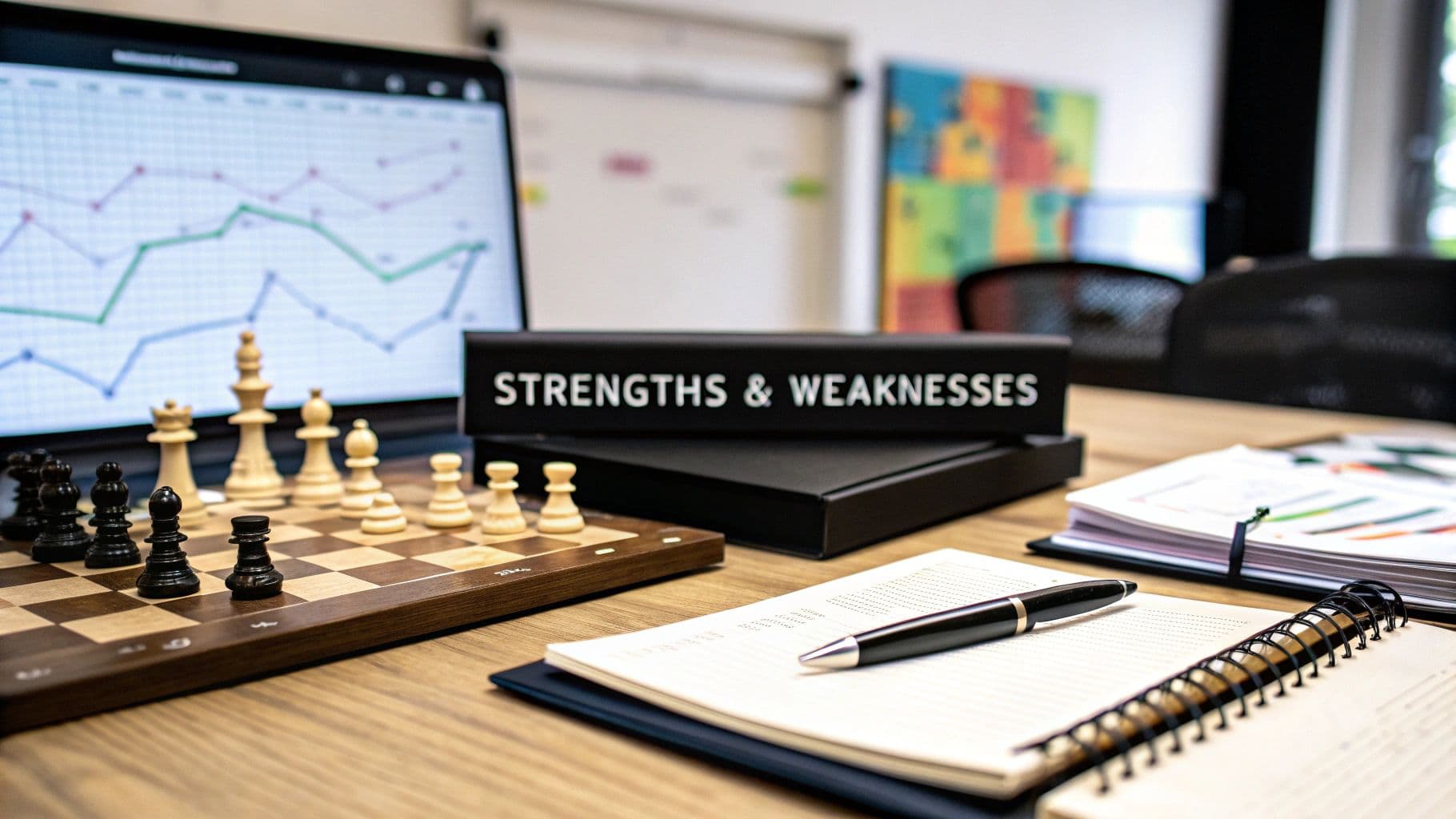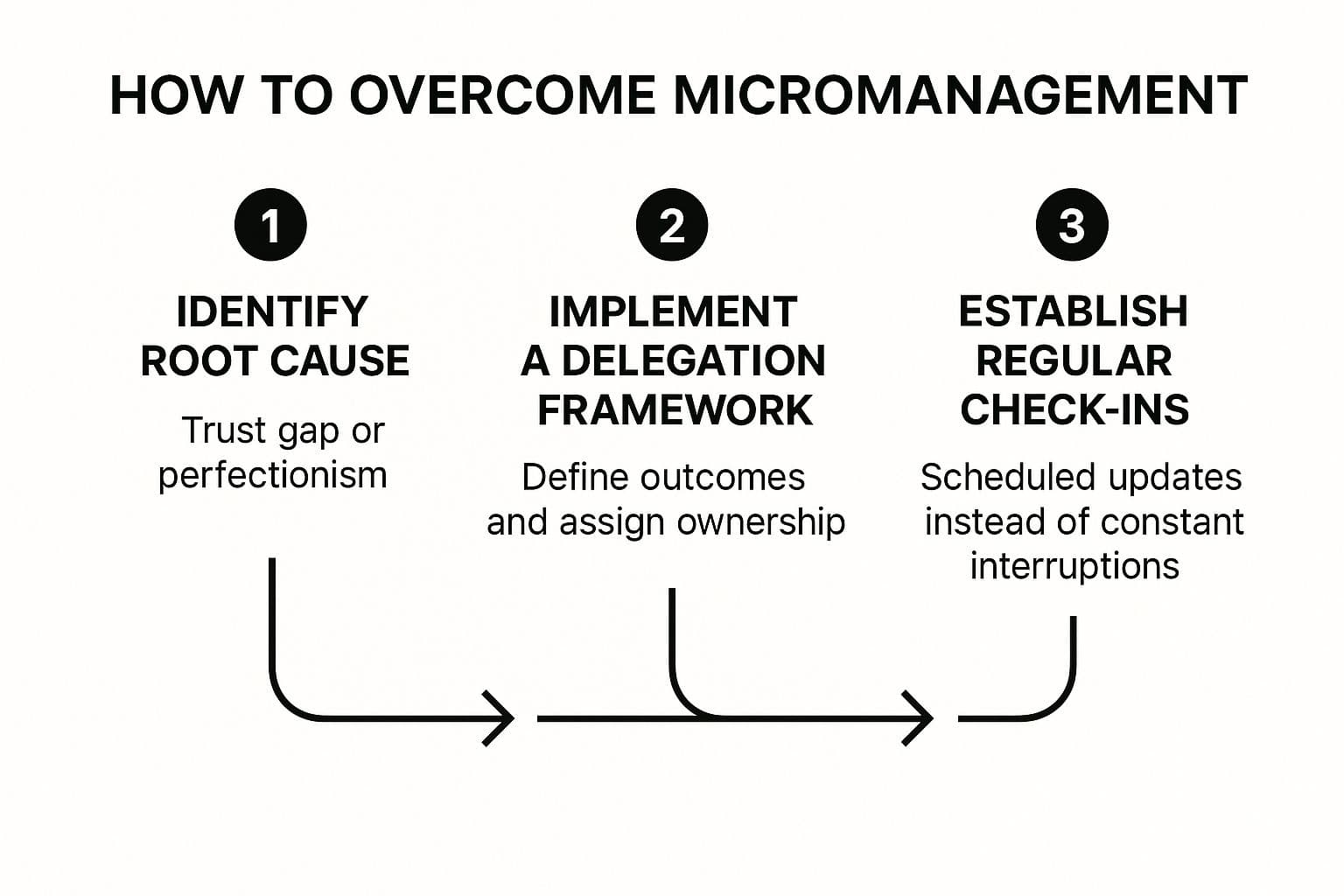Master Leadership Strengths & Weaknesses in 2025
Learn essential leadership strengths weaknesses with practical tips and examples to boost your skills and succeed in your career today.

Understanding and articulating your leadership strengths and weaknesses is more than just a prerequisite for acing a behavioral interview; it's a fundamental requirement for effective management in high-stakes environments. For professionals targeting elite roles in consulting, finance, or product management, the ability to demonstrate profound self-awareness, coupled with a strategic plan for growth, is a non-negotiable differentiator. This isn't about memorizing a list of positive and negative traits. It’s about deeply analyzing how your specific attributes translate into tangible outcomes, both for your team and the organization.
This guide is engineered to move you beyond surface-level answers. We will dissect eight of the most critical leadership qualities, from visionary thinking and emotional intelligence to common pitfalls like micromanagement and poor communication. For each item, you will find a detailed breakdown, including:
- Strategic Analysis: Unpacking the "why" behind each trait's impact.
- Interview-Ready Phrasing: Concrete examples of how to frame your skills and development areas.
- Actionable Improvement Tactics: Specific, replicable methods for amplifying your strengths and systematically mitigating your weaknesses.
The goal is to equip you with a sophisticated framework for self-assessment. By understanding the nuances of your own leadership strengths and weaknesses, you can transform a standard interview question into a compelling narrative of your potential, turning self-awareness into your most powerful career asset. Let's begin the breakdown.
1. Emotional Intelligence (EQ) - Strength
Emotional Intelligence (EQ) is a critical leadership strength, representing the ability to perceive, understand, and manage your own emotions while simultaneously recognizing and influencing the emotions of others. High-EQ leaders excel at navigating complex social dynamics, fostering strong team cohesion, and building psychologically safe work environments where innovation can flourish. It is a cornerstone of modern leadership, moving beyond traditional command-and-control styles to a more empathetic and collaborative approach.

This strength is a composite of five core skills: self-awareness, self-regulation, motivation, empathy, and social skills. When considering leadership strengths and weaknesses, a high EQ allows a leader to remain poised under pressure (self-regulation) and connect with their team’s motivations (empathy), directly impacting performance and retention.
Strategic Application and Impact
A powerful example of EQ in action is Satya Nadella’s cultural transformation at Microsoft. He shifted the company from a competitive, "know-it-all" internal culture to a collaborative, "learn-it-all" one. By championing empathy, Nadella enabled teams to better understand customer needs and work together, leading to a resurgence in innovation and market dominance.
Similarly, former PepsiCo CEO Indra Nooyi demonstrated EQ by writing personal letters to the parents of her senior executives, acknowledging their role in their children's success. This simple act fostered deep loyalty and showed a profound personal investment in her team, proving that emotional connection can be a powerful business tool.
How to Develop and Demonstrate Your EQ
To cultivate this leadership strength, focus on practical, consistent actions.
- Practice Active Listening: When a team member speaks, focus entirely on understanding their perspective before formulating your response. Avoid the urge to immediately jump to solutions.
- Keep an Emotion Journal: Regularly document situations that trigger strong emotional responses. This practice builds self-awareness by helping you identify patterns in your behavior and reactions.
- Seek 360-Degree Feedback: Actively request feedback from peers, direct reports, and superiors specifically on your interpersonal skills and emotional management.
- Master the Pause: In high-stress moments, intentionally take a brief pause before speaking or acting. This creates a crucial space for self-regulation, preventing impulsive reactions.
By developing your EQ, you build the foundation for a resilient, engaged, and high-performing team.
2. Visionary Thinking - Strength
Visionary thinking is a paramount leadership strength, defined by the ability to conceptualize and articulate a compelling, long-term future. These leaders see beyond the immediate horizon, identifying emerging trends and creating a clear strategic path that inspires action. They are adept at connecting the day-to-day tasks of their team to a larger, more meaningful purpose, transforming work into a shared mission.

This strength is about more than just having an idea; it's about making that idea accessible, exciting, and achievable for others. When evaluating leadership strengths and weaknesses, a leader's ability to create and sustain a powerful vision is what separates managers from true trailblazers. It provides the "why" that fuels motivation, resilience, and innovation within an organization.
Strategic Application and Impact
Steve Jobs at Apple is a quintessential example of visionary leadership. He didn’t just aim to build computers; he envisioned a future where technology was intuitive, elegant, and seamlessly integrated into people's lives. This vision guided every product decision, from the Macintosh to the iPhone, and rallied his teams to create products that repeatedly redefined entire industries.
Similarly, Elon Musk's vision for a sustainable energy future and multi-planetary existence drives the ambitious goals of Tesla and SpaceX. His ability to articulate these massive, almost science-fiction-like goals has attracted top talent and immense capital, proving that a powerful vision can make the seemingly impossible feel inevitable. This kind of forward-thinking is essential in fields like consulting, where envisioning future states for clients is key. Discover how to develop this skill for a career in consulting.
How to Develop and Demonstrate Your Visionary Thinking
Cultivating this leadership strength requires a blend of creativity and strategic communication.
- Connect Daily Tasks to the Big Picture: Regularly explain to your team how their specific projects contribute directly to the organization's overarching mission.
- Study Trends Beyond Your Industry: Dedicate time to reading and learning about innovations in unrelated fields. This cross-pollination of ideas is a key source of visionary insight.
- Use Storytelling: Craft and share compelling narratives about the future you are trying to build. Stories are more memorable and emotionally resonant than data points alone.
- Balance Vision with Execution: Create clear, tangible milestones that demonstrate progress toward the long-term vision. This keeps the team grounded and motivated, preventing the vision from feeling like a distant dream.
By developing visionary thinking, you provide the direction and inspiration necessary to lead your team through challenges and toward groundbreaking achievements.
3. Micromanagement - Weakness
Micromanagement is a leadership weakness characterized by excessive control and over-involvement in a team's work. Leaders who micromanage often struggle to delegate effectively, closely monitoring every detail of a task and correcting processes along the way. This style typically stems from a leader's insecurity, perfectionism, or a fundamental lack of trust in their team's abilities, creating a significant bottleneck that stifles creativity, autonomy, and professional growth.
This behavior, while often well-intentioned, is a critical issue when evaluating leadership strengths and weaknesses. It erodes morale and teaches team members that their judgment is not valued, leading to dependency and disengagement. Over time, high-performing employees will leave for environments that offer greater trust and ownership, while those who remain become less inclined to take initiative.
Strategic Application and Impact
A classic example of this weakness is the early leadership style of Steve Jobs at Apple. His obsession with minute details, from the curve of a device's corner to the specific shade of a color, drove product excellence but also created a high-stress environment and significant employee turnover. While the results were sometimes legendary, the process was often unsustainable and demoralizing for his teams.
Similarly, many startup founders exhibit micromanagement tendencies as their companies scale. Having been hands-on in every aspect of the business from the start, they find it difficult to transition to a delegative role. This failure to let go can cripple a growing organization, as the founder becomes the single point of failure for decisions, slowing down innovation and preventing other leaders from developing.
How to Overcome and Avoid Micromanagement
To shift from a micromanager to a true leader, you must consciously build trust and create systems that support autonomy.
The infographic below outlines a simple three-step process to begin breaking the cycle of micromanagement.

This process flow moves a leader from reactive control to structured empowerment, addressing the underlying issue rather than just the symptoms.
- Practice Outcome-Based Delegation: Define what needs to be achieved and by when, but let your team determine how to do it. Focus on results, not methods.
- Establish a Check-in Cadence: Replace constant "shoulder-tapping" with scheduled, predictable updates (e.g., daily stand-ups or weekly one-on-ones). This provides oversight without suffocating your team.
- Invest in Training: Often, a lack of trust is rooted in a perceived skills gap. Proactively develop your team's capabilities through mentoring and training, giving you the confidence to delegate more significant responsibilities.
- Reward Independent Problem-Solving: When a team member resolves an issue without your intervention, publicly acknowledge and celebrate their initiative. This reinforces the value of autonomy.
4. Decisiveness - Strength
Decisiveness is the ability to make timely, clear decisions, even with incomplete information or in the face of uncertainty. Decisive leaders analyze available data quickly, trust their judgment, take calculated risks, and commit to a course of action. They understand that delayed decisions often cost more than imperfect ones and that organizational momentum requires clear direction.

This trait is a critical component when evaluating leadership strengths and weaknesses. A decisive leader provides the clarity and momentum a team needs to move forward, preventing analysis paralysis and fostering a culture of action. They are skilled at distinguishing between irreversible "one-way door" decisions that require deep deliberation and reversible "two-way door" decisions that can be made quickly.
Strategic Application and Impact
A prime example of decisiveness is Howard Schultz's return to Starbucks in 2008. Amidst a financial crisis and declining brand perception, he made the bold decision to close all 7,100 U.S. stores for an afternoon of barista retraining. This decisive, highly public move signaled a renewed commitment to quality, re-energized the company culture, and was a key first step in saving the brand from collapse.
Similarly, Anne Mulcahy’s leadership at Xerox showcases this strength. Facing bankruptcy, she made a series of rapid, tough decisions to divest non-core assets, restructure debt, and overhaul the business model. Her ability to make these difficult choices quickly and communicate them clearly was instrumental in steering Xerox away from financial ruin and setting it on a path to recovery.
How to Develop and Demonstrate Your Decisiveness
To build this crucial leadership strength, you must practice making choices under pressure and create systems for clarity.
- Use Decision-Making Frameworks: Distinguish between one-way and two-way door decisions, as popularized by Jeff Bezos. Apply more rigor to irreversible choices and empower yourself and your team to make reversible ones faster.
- Set Time Limits: For most decisions, set a specific deadline. This forces you to focus on the most critical information and prevents endless deliberation.
- Apply the 70% Rule: Make a decision once you have approximately 70% of the information you need. Waiting for 100% certainty is often impossible and leads to missed opportunities.
- Communicate the "Why": After making a decision, clearly articulate the reasoning behind it to your team. This builds trust and alignment, even if some disagree with the final call.
By consciously practicing these techniques, you can transform decisiveness from a potential challenge into a cornerstone of your leadership style.
5. Poor Communication - Weakness
Poor communication is a critical leadership weakness, representing the failure to convey information, expectations, and vision clearly and consistently. It manifests as unclear instructions, infrequent updates, a failure to listen, and inconsistent messaging. This gap creates confusion, erodes trust, and fosters a culture of misalignment and inefficiency, directly undermining a team's ability to execute effectively.
This weakness is a direct counterpart to the most essential leadership skills. Leaders who struggle with communication often fail to set clear goals, provide constructive feedback, or inspire their teams. When evaluating leadership strengths and weaknesses, the inability to articulate a coherent strategy or listen to employee concerns is a significant liability that can cripple even the most talented organizations.
Strategic Application and Impact
A stark example of poor communication's impact can be seen in Yahoo's decline under multiple leadership transitions. A constantly shifting strategic direction, communicated poorly and inconsistently to employees, created widespread confusion and disengagement. This lack of a unified message from the top prevented teams from aligning their efforts, contributing to a loss of market position and eventual sale.
Similarly, the downfall of Theranos was fueled by a culture of secrecy and one-way communication championed by Elizabeth Holmes. By controlling the flow of information and discouraging questions, the leadership team concealed critical failures and created an environment where fraud could fester. This illustrates how poor communication can have catastrophic ethical and financial consequences.
How to Improve and Overcome This Weakness
To overcome this leadership weakness, focus on creating systems for clarity and consistency.
- Implement Communication Rhythms: Establish a predictable schedule for updates, such as daily stand-ups, weekly team emails, and monthly all-hands meetings. This creates structure and manages expectations.
- Practice Active Listening: Treat listening as an active skill. When team members speak, paraphrase their points to confirm understanding ("So, what I'm hearing is...") before responding.
- Use the "Echo Effect": Reinforce crucial messages by repeating them across multiple channels (e.g., in a meeting, via email, and on a Slack channel).
- Master One-on-Ones: Use dedicated, regular one-on-one meetings to create a safe space for two-way dialogue, ensuring you understand individual concerns and provide tailored guidance.
Improving these fundamental skills is non-negotiable for effective leadership. For a deeper dive into this area, learn more about the essential communication skills for interviews and professional success.
6. Adaptability and Resilience - Strength
Adaptability and resilience represent a leader's capacity to adjust strategies in response to changing circumstances while maintaining composure and optimism during setbacks. This crucial leadership strength enables leaders to pivot when necessary, learn from failures, and guide their teams through uncertainty. In today's volatile business environments, adaptability is not just a benefit; it is a core requirement for survival and growth.
This strength is a powerful combination of proactive change management (adaptability) and reactive strength (resilience). When assessing leadership strengths and weaknesses, a leader high in this trait can steer an organization through disruptive market shifts and internal crises alike. They don't just endure change; they leverage it as an opportunity for innovation and improvement.
Strategic Application and Impact
A prime example of adaptability is Netflix's evolution. Under Reed Hastings, the company disrupted its own successful DVD-by-mail model to pioneer streaming. It then adapted again by investing billions to become a premier content producer, transforming from a distributor into a global entertainment powerhouse. Each pivot required immense foresight and the resilience to weather initial investor skepticism and technical challenges.
Similarly, Satya Nadella’s leadership at Microsoft showcases this strength. He pivoted the company's entire identity from a Windows-centric model to a "cloud-first, mobile-first" strategy. This required fundamentally re-engineering the company's culture and business priorities, a monumental task that demonstrated both strategic adaptation to market trends and the resilience to see the transformation through.
How to Develop and Demonstrate Your Adaptability
To cultivate this leadership strength, focus on building both a flexible mindset and robust coping mechanisms.
- Practice Scenario Planning: Regularly dedicate time with your team to brainstorm potential futures and map out responses. This prepares you mentally and operationally for various contingencies.
- Conduct Post-Mortems on Failures: Instead of assigning blame, lead blameless reviews of projects that didn't succeed. Focus on extracting key lessons to build institutional knowledge and resilience.
- Cultivate a Growth Mindset: Actively seek out new skills and information outside your comfort zone. Championing a "learn-it-all" culture, as Nadella did, encourages your team to see challenges as learning opportunities.
- Communicate the 'Why': During periods of change, clearly and consistently communicate the rationale behind the decisions. This builds trust and helps your team stay aligned and motivated through uncertainty.
By developing adaptability and resilience, you equip yourself and your team to thrive in an unpredictable world.
7. Failure to Develop Others - Weakness
A failure to develop others is a critical leadership weakness, marked by an inability or unwillingness to invest in the growth of team members. Leaders exhibiting this weakness often hoard knowledge, avoid meaningful delegation, and prioritize short-term results over building long-term organizational capability. This oversight severely limits a team's potential, stifles innovation, and creates a fragile talent pipeline, ultimately harming employee morale and the company's future.
This weakness often stems from a leader's insecurity, a lack of management training, or an intense focus on their own individual contributions. When analyzing leadership strengths and weaknesses, failing to cultivate talent is a significant liability that leads to high turnover and a stagnant skill set within the organization, leaving it vulnerable when key individuals depart.
Strategic Application and Impact
A common example of this weakness is found in organizations that promote top-performing technical experts into management roles without providing leadership training. A star software engineer, for instance, might continue to solve the hardest coding problems themselves instead of coaching their team to build those skills. This approach creates a bottleneck, demotivates aspiring engineers, and fails to scale the team’s overall expertise.
Conversely, a powerful counterexample is Jack Welch's tenure at GE. Despite other controversies, his relentless focus on talent development was legendary. He famously spent a huge portion of his time on people, reviewing and mentoring leaders and ensuring a robust succession plan. This commitment created a powerful "leadership factory," proving that investing in people is a direct investment in the company's sustained success.
How to Overcome This Weakness
To transition from a task-master to a talent-developer, leaders must adopt intentional, people-centric habits.
- Schedule Dedicated Development Check-ins: Hold regular one-on-ones that are explicitly focused on career aspirations and skill growth, separate from tactical project updates.
- Create Individual Development Plans (IDPs): Collaborate with each team member to set clear, actionable development goals with specific timelines and measurable outcomes.
- Delegate for Growth, Not Just Relief: Assign stretch projects that push team members beyond their current comfort zones, providing support and guidance along the way.
- Establish Mentorship Programs: Actively connect junior members with senior mentors and encourage peer-to-peer coaching to build a supportive learning ecosystem. This is a key skill emphasized in many high-stakes roles, which you can explore further as you prepare for consulting interviews.
By actively nurturing talent, you build a resilient, capable, and engaged team that can drive long-term success.
8. Accountability and Integrity - Strength
Accountability and integrity are the twin pillars of trustworthy leadership. This strength represents an unwavering commitment to ethical principles, taking ownership of outcomes, and holding oneself and the team to the highest standards. Leaders who embody integrity act with honesty and transparency, while those who practice accountability accept responsibility for mistakes and follow through on commitments. Together, they create a culture of trust and psychological safety, which is essential for sustainable success.
This strength is not about perfection; it is about consistently aligning actions with values. When evaluating leadership strengths and weaknesses, integrity is non-negotiable. It ensures that decisions are made for the right reasons, while accountability guarantees that the results of those decisions, good or bad, are owned. This builds credibility and fosters an environment where team members feel empowered to take calculated risks.
Strategic Application and Impact
A powerful example of this strength is the cultural overhaul at Microsoft led by Satya Nadella. He shifted the company from a culture of internal competition to one of a "growth mindset," where accountability was reframed. Instead of blaming others for failures, leaders were expected to own them as learning opportunities. This change fostered greater collaboration and psychological safety, directly contributing to the company's resurgence.
Similarly, Patagonia's founder, Yvon Chouinard, built an entire brand on a foundation of environmental integrity and accountability. The company transparently admits its own environmental footprint and holds itself accountable for reducing it, such as through its "Don't Buy This Jacket" campaign. This radical honesty has built immense brand loyalty and proved that a commitment to integrity can be a significant competitive advantage.
How to Develop and Demonstrate Accountability and Integrity
Cultivating this leadership strength requires intentional and consistent effort.
- Model Radical Ownership: When a project or initiative fails, be the first to publicly own your role in the outcome. Clearly state what you learned and what you will do differently next time.
- Define and Communicate Core Values: Explicitly outline the ethical principles for your team or organization. Refer to these values when making difficult decisions to demonstrate their practical importance.
- Establish Clear Consequences: Implement and enforce consistent consequences for ethical lapses, regardless of an individual's performance level. This shows that integrity is valued above all else.
- Seek Feedback on Your Consistency: Ask your team and peers if your actions consistently align with your stated values. This invites accountability and shows you are committed to closing any gaps.
By embedding accountability and integrity into your leadership style, you build a resilient organization grounded in trust.
Leadership Strengths and Weaknesses Comparison
| Leadership Attribute | Implementation Complexity 🔄 | Resource Requirements ⚡ | Expected Outcomes 📊 | Ideal Use Cases 💡 | Key Advantages ⭐ |
|---|---|---|---|---|---|
| Emotional Intelligence (EQ) | Moderate - requires ongoing coaching & reflection | Medium - time for feedback & mindfulness practices | Improved team trust, engagement, and psychological safety | Complex interpersonal dynamics, team leadership | Builds trust, reduces conflict, enhances engagement |
| Visionary Thinking | High - demands creativity and strategic foresight | Moderate - needs communication channels & storytelling | Clear strategic direction, motivated teams, innovation | Long-term planning, cultural transformation | Inspires teams, fosters innovation, competitive edge |
| Micromanagement (Weakness) | High - involves excessive control and detail oversight | High - leader time heavily consumed | Low morale, bottlenecks, reduced innovation | Rarely ideal; temporary in-risk scenarios | Early error detection in critical tasks (limited) |
| Decisiveness | Moderate - requires decision frameworks and discipline | Low to medium - rapid info processing and consultation | Faster decisions, clear direction, accountability | Crisis response, fast-moving markets | Maintains momentum, reduces ambiguity, builds confidence |
| Poor Communication (Weakness) | Low - often results from neglect, but impacts widely | Low - no investment leads to dysfunction | Confusion, errors, low trust, poor engagement | Avoid at all costs; affects all organizational levels | None |
| Adaptability and Resilience | Moderate - requires mindset shifts & stress management | Medium - investment in learning & psychological safety | Agile teams, innovation, sustained morale | Volatile environments, crisis management | Enables survival, models positivity, accelerates recovery |
| Failure to Develop Others (Weakness) | Low to moderate - often neglect, no clear systems | Low to medium - lack of coaching & training | Limited growth, succession gaps, high turnover | Avoid - critical for sustained org capacity | None |
| Accountability and Integrity | Moderate - needs clear values and enforcement systems | Medium - communication and auditing structures | High trust, ethical culture, reputation enhancement | Ethics-critical roles, high-trust environments | Builds deep trust, ethical decision-making, strong culture |
Putting It All Together: Your Path to Impactful Leadership
The journey through the landscape of leadership strengths and weaknesses reveals a fundamental truth: effective leadership is not about achieving perfection. It is not a static checklist of flawless attributes. Instead, it is a dynamic process of continuous self-awareness, intentional development, and strategic application. The most impactful leaders are not those without faults; they are those who possess a profound understanding of their own leadership profile and actively work to leverage their strengths while mitigating their weaknesses.
The concepts we've explored, from the empowering force of Visionary Thinking to the corrosive effects of Micromanagement, are more than just interview talking points. They are the core components that determine a leader's ability to inspire a team, drive results, and build a resilient organizational culture. True mastery lies in recognizing the interconnectedness of these traits. For instance, high Emotional Intelligence (EQ) is the foundation that makes Decisiveness effective rather than autocratic, and it’s the antidote to the trust erosion caused by Poor Communication.
Key Takeaways: From Awareness to Action
As you reflect on the strengths and weaknesses detailed in this article, concentrate on shifting from passive acknowledgment to proactive strategy. Your goal is to build a personal leadership development framework.
- Embrace the Duality: Every strength, when overused or applied in the wrong context, can become a weakness. A decisive leader can become impulsive; a visionary thinker can lose touch with operational reality. The key is situational awareness and balance.
- Weaknesses Are Development Opportunities: Framing a weakness like a Failure to Develop Others not as a permanent flaw but as a skill gap is crucial. It transforms a vulnerability into a clear, actionable goal for improvement, such as implementing structured mentorship programs or refining delegation techniques.
- Build a Feedback Engine: You cannot accurately assess your leadership strengths weaknesses in a vacuum. Actively and consistently seek 360-degree feedback from superiors, peers, and direct reports. This input is the data you need to challenge your assumptions and identify blind spots.
Your Strategic Next Steps
Translating this knowledge into tangible progress requires a deliberate plan. For ambitious professionals, especially those targeting elite roles in consulting, finance, or product management, articulating this self-awareness is just as important as possessing it.
- Conduct a Personal Audit: Go back through the list of strengths and weaknesses. Honestly assess where you stand on each. For every strength, identify a specific project where you successfully applied it. For every weakness, pinpoint a past situation where it hindered you or your team. This creates a portfolio of tangible examples.
- Craft Your Narrative: Practice articulating your leadership profile. The STAR (Situation, Task, Action, Result) method is invaluable here. For a strength like Adaptability, frame a story: "In a situation where market data shifted unexpectedly, my task was to pivot our project strategy. I took the action of leading a rapid reassessment, and the result was that we successfully launched a more relevant product."
- Create a Development Plan: Choose one weakness to focus on for the next quarter. If it's Poor Communication, your plan might include taking a public speaking course, initiating weekly team check-ins for alignment, or asking a mentor to review your written communications. Measurable actions lead to real growth.
Ultimately, the rigorous examination of your leadership strengths weaknesses is the highest form of professional development. It is the work that separates competent managers from truly transformative leaders. This journey of introspection and improvement is not just about securing your next role; it is about building the capacity to create lasting value, empower those around you, and lead with both confidence and humility. Your leadership legacy begins with the honest work you are willing to do today.
Ready to translate your leadership awareness into interview-winning performance? Soreno provides an AI-powered platform to practice articulating your strengths and weaknesses in a realistic, high-pressure mock interview environment. Get instant, detailed feedback on your communication, structure, and content to ensure you present yourself as the confident, self-aware leader top firms are looking for.